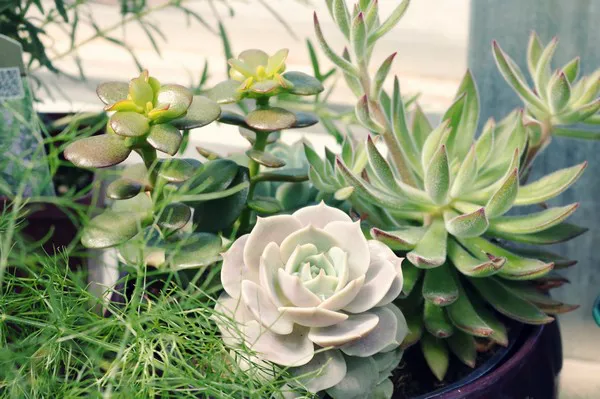Succulents, with their striking beauty and resilience, have become increasingly popular in gardens and outdoor landscapes. These water-storing plants are known for their ability to thrive in arid conditions, making them an ideal choice for those seeking low-maintenance greenery. However, the question of how much water succulents need outside is crucial to their health and longevity. In this comprehensive article, we will delve into the intricate world of succulents, exploring their water requirements in an outdoor setting.
Understanding the Nature of Succulents
Before we embark on the journey of determining the water needs of succulents outdoors, it is essential to understand the basic characteristics of these unique plants. Succulents belong to a diverse group of species that have adapted to store water in their leaves, stems, and roots. This adaptation allows them to survive in regions with limited water availability, such as deserts and arid landscapes.
One key feature of succulents is their ability to endure periods of drought by storing water in specialized tissues. This adaptation enables them to withstand dry conditions and thrive in environments where other plants might struggle to survive. However, this does not mean succulents are completely immune to the need for water.
Factors Influencing Water Requirements
To determine how much water succulents need outdoors, it is crucial to consider various factors that influence their water requirements. Understanding these factors will enable gardeners and plant enthusiasts to create optimal growing conditions for their succulents. Here are the key factors to take into account:
1. Species and Variety: Different succulent species and varieties have varying water needs. While some may thrive in extremely arid conditions, others might require more frequent watering. Researching the specific requirements of the succulents in your garden is paramount for their well-being.
2. Climate and Location: The climate and geographical location play a significant role in determining how much water succulents need. Succulents in a hot, dry climate will likely require more frequent watering than those in a milder, more humid environment. Understanding the local climate is crucial for adapting watering routines accordingly.
3. Soil Type and Composition: Succulents thrive in well-draining soil. The type and composition of the soil in which they are planted influence their water absorption. Sandy or gravelly soils are preferable, as they allow excess water to drain away quickly, preventing root rot—a common issue for succulents in waterlogged conditions.
4. Container vs. Ground Planting: Whether succulents are planted in containers or directly in the ground affects their water requirements. Container-grown succulents may dry out more quickly than those planted in the ground, necessitating more frequent watering.
5. Seasonal Variations: Succulents may have different water needs depending on the season. During their active growing season, which is typically spring and summer, succulents may require more water. Conversely, in dormant periods like fall and winter, they need less moisture.
Establishing a Watering Routine
Now that we have a foundational understanding of the factors influencing succulent water requirements, it’s time to explore how to establish an effective watering routine for outdoor succulents. The goal is to provide adequate moisture without overwatering, which can lead to root rot and other complications.
1. Monitor Soil Moisture: The most effective way to determine when to water succulents is by monitoring the moisture level of the soil. Inserting a finger into the soil up to the second knuckle will give you a sense of its moisture content. Water only when the top inch or two of the soil feels dry.
2. Watering Frequency: The frequency of watering will depend on the factors mentioned earlier, such as climate, soil type, and the specific succulent species. Generally, it’s better to underwater than overwater succulents. Allow the soil to dry out between watering sessions to mimic the natural conditions these plants thrive in.
3. Morning Watering: When watering succulents outside, it is advisable to do so in the morning. This allows the plants to absorb the moisture before the heat of the day, reducing the risk of fungal issues and evaporation.
4. Use a Soaker Hose or Watering Can: Opt for a soaker hose or a watering can with a narrow spout to deliver water directly to the base of the succulents. This method helps avoid wetting the leaves, preventing potential rot and fungal diseases.
5. Mulching: Applying a layer of mulch around succulents can help retain soil moisture and regulate temperature. However, it’s crucial not to mulch too close to the base of the plants to prevent excess moisture retention.
Signs of Overwatering and Underwatering
Recognizing the signs of overwatering and underwatering is essential for maintaining the health of outdoor succulents. Observing the following indicators will guide adjustments to your watering routine:
1. Overwatering Signs:
- Yellowing or softening of leaves
- Mushy or blackened roots
- Foul odor emanating from the soil
- Presence of mold or fungus on the soil surface
2. Underwatering Signs:
- Shriveling or wrinkling of leaves
- Stunted growth
- Leaves becoming discolored or taking on a dull appearance
- Slow recovery after watering
Conclusion:
Balancing the art of providing sufficient moisture without succumbing to the pitfalls of overwatering requires observation, patience, and a willingness to adapt. As guardians of these resilient and captivating plants, our role is to mimic the conditions they evolved to thrive in, ensuring a harmonious relationship between succulents and the outdoor environment they call home. So, go ahead, unlock the secrets, and let your outdoor succulents flourish in all their glory.


